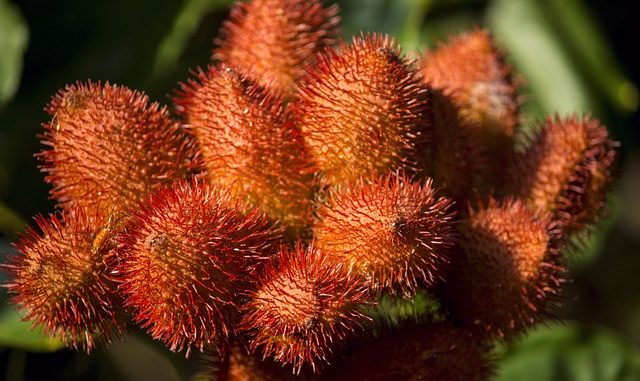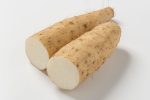
Annatto is the name of a colour but is also the name of the seeds that come from a tropical bush called Bixa orellana. The major colour compound in annatto is cis-bixin which is the monomethyl ester of the diapocarotenoic acid known as norbixin. It is a carotenoid pigment. The pigment is prepared by extracting the seed pulp which is rich Bixin makes up 80 per cent of the total pigment content.
The proper name of norbixin is 9′-cis-6,6′-diapocarotene-6,6′-dioic acid. Norbixin is obtained by saponification of bixin using alkaline solutions such as NaOH and KOH to form a salt in polar solvents (Scotter, 2009).
The two colours, bixin and norbixin are both oil soluble.
In labelling terms it is known as E160b.
The annatto is a bush growing between 3m and 6m high. It is native to Central and South America where it seeds are used extensively to colour food and clothes. The fruit is a burr-like pod containing between 20 and 50 seeds which are the size of grape seeds. These are covered with a thick layer of soft red pulp which is the source of the colour.
Annatto is also known as orlean, achiote, urucum, rocou. It is cultivated in many tropical countries but especially Mexico, Jamaica, Peru, Brazil, Kenya and Philippines as major centres of supply. Roughly 80 per cent of production of annatto colour is used by the USA and Western Europe. The amount varies between 10K and 11K Tonnes. It is primarily used to colour butter, margarine and cheese.
Annatto has a long established history as a food colour. It is mainly used for colouring butter, margarine and cheese. Historically, annatto was also used as a spice to flavour fish, pork, chicken and rice in Mexico but in more recent years now flavours paella, curry and chili products.
Analysis of Annatto and Bixin In Foods
Analyzing annatto in foods involves detecting its main pigments, bixin and norbixin, which give the characteristic yellow to orange colour.
1. Spectrophotometry:
- Principle: Measures the absorbance of light by bixin and norbixin at specific wavelengths.
- Process: Annatto is extracted using solvents like acetone or ethanol, and the absorbance is measured — usually at 453 nm for bixin and 482 nm for norbixin.
- Use: Simple, cost-effective method for routine analysis, but less precise for complex food matrices.
2. High-Performance Liquid Chromatography (HPLC):
- Principle: Separates bixin and norbixin based on their interactions with a stationary phase and a mobile phase.
- Process: After solvent extraction, the sample is injected into the HPLC system, and the pigments are detected using a UV-Vis detector (typically around 450 nm).
- Use: Highly accurate for identifying and quantifying pigments, even in complex foods like cheese or margarine.
3. Thin-Layer Chromatography (TLC):
- Principle: Separates pigments on a plate coated with a stationary phase.
- Process: Extracted annatto is spotted onto a TLC plate, developed in a solvent system, and visualized under UV light or using color reactions.
- Use: A quick, qualitative method to confirm the presence of annatto.
4. Mass Spectrometry (MS):
- Principle: Identifies compounds by their mass-to-charge ratio.
- Process: Often coupled with HPLC (HPLC-MS), allowing both separation and detailed identification of bixin and norbixin.
- Use: Useful for detecting trace levels of annatto and distinguishing it from other carotenoids.
5. Capillary Electrophoresis (CE):
- Principle: Separates pigments based on their size and charge under an electric field.
- Use: Offers high resolution and speed, useful for complex food matrices.
6. Enzyme-Linked Immunosorbent Assay (ELISA):
- Principle: Uses antibodies that specifically bind to bixin or norbixin.
- Use: Suitable for rapid screening and detecting very low levels of annatto.
Sample Preparation:
- Extraction: Depends on the food matrix — oils may use hexane, while dairy products may use ethanol or acetone.
- Hydrolysis: Sometimes, chemical treatments (like acid hydrolysis) are used to convert bixin to norbixin for better detection.
Use in Product Development
Processed cheeses, including analog cheese are very simply prepared by blending uncoloured Cheddar cheese with process water, 3% emulsifying salt in a 70:30 sodium citrate: disodium phosphate buffer. Annatto colours are added to the cheese paste to 0.3% v/v and mixed to uniformity.
Stability
ASLT is often used to examine colour stability over a short period of time as a way of understanding the longer-term stability of the colour. The thermal stability of norbixin and bixin in fresh orange juice was assessed at refrigeration temperatures between 7 and 10ºC and at room temperature of 25 to 30ºC. This was to stimulate storage conditions for a long period of time of 5 months. There was significant loss of norbixin at the higher temperatures. (Prabhakara Rao et al., 2002).
In cheese, the colour component is between 10 and 20% of the solid material. It contains up to 11% alpha-norbixin.
Pink Discolouration
Processed cheeses coloured with annatto have a tendency towards pink discolouration. It occurs throughout the body of a processed cheese and is not light-induced either. When pink colours form the cheese is often reworked into others to recover the cheese. The issue has been known about since 1930s. The colour develops when cheese is heated at a higher temperature over extended time periods. The level of pink colour increases with temperature.
The pink colour is sometimes described as pink-brown to salmon (Kosikowski, 1982). Some have reported the pinkiness develops with aging and when the pH is slightly acidic (Zehren & Nusbaum, 1992).
Encapsulation
Annatto, bixin and norbixin have all been stabilised to some extent by microencapsulation.
References
Barbosa, M.I.M.J., Borsarelli, C.D., Mercadante, A.Z., 2005. Light stability of spray-dried bixin encapsulated with different edible polysaccharide preparations. Food Res. Int. 38, pp. 989–994. (Article)
Hong, C.M., Wendorff, W.L., and Bradley, R.L. 1995. Factors affecting light-induced pink discoloration of annatto-colored cheeses. J. Food Sci. 60 pp. 94-97
Kosikowski, F.V. (1982). Cheese and Fermented Milk Foods. 2nd ed. F.V. Kosikowskiand Assoc., Brooktendale, NY
Prabhakara Rao, P.G., Jyothirmayi, T., Balaswamy, K., Satyanarayana, A., Rao, D.G., 2005. Effect of processing conditions on the stability of annatto (Bixa orellana L.) dye incorporated into some foods. LWT Food Sci. Technol. 38, 779–784. (Article)
Prabhakara Rao, P.G., Satyanarayana, A., Rao, D.G., 2002. Effect of storage on the stability of water soluble annatto dye formulation in a simulated orange-RTS beverage model system. LWT Food Sci. Technol. 35, pp. 617–621. (Article)
Reith, J. F., & Gielen, J. W. (1971). Properties of bixin and norbixin and the composition of annatto extracts. Journal of Food Science, 36(6), pp. 861-864 (Article).
Scotter, M., 2009. The chemistry and analysis of annatto food colouring: a review. Food Addit. Contam. A Chem. Anal. Control Expo Risk Assess. 26, pp. 1123–1145. (Article)
Zehren, V.L. and Nusbaum, D.D. (1992). Process Cheese. Cheese Reporter Publ. Co., Madison, WI


Leave a Reply